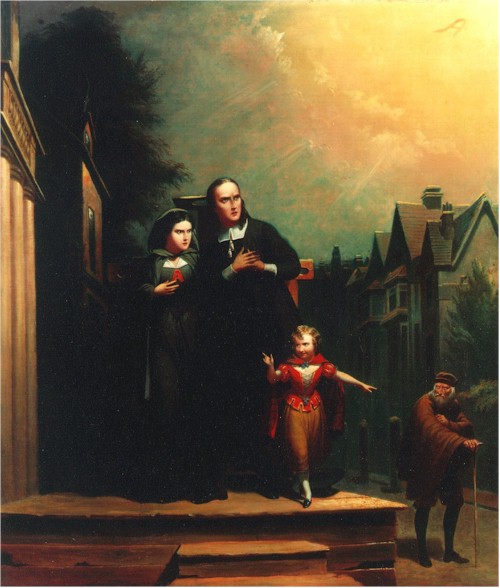

This section again shows Dimmesdale’s inability to maintain his connection with Hester and Pearl, and more importantly, that his personality of timidity and self-preservation prevails over his actions.īy the last scaffold scene, Dimmesdale’s change becomes clearer through his actions and words. Still, Hawthorne reiterates that Dimmesdale has not completely changed from his cowardice and dispassionate self because when Pearl asks Dimmesdale whether or not he will join them again tomorrow at noon, he replies negatively. Their unified presence prompts rejuvenation within Dimmesdale because Hester and Pearl replace the missing links “as if the mother and the child were communicating their vital warmth to his half-torpid system” (137). This short, yet powerful connection with Hester and Pearl stimulates a vital strength in Dimmesdale and the three are able to form and “electric chain.” Hawthorne effectively uses an “electric chain” when describing the three because an electric chain possesses no power or strength when a link is missing, and, similarly, Dimmesdale feels lost in solitude when no connection exists between Hester, Pearl and himself. When Dimmesdale acknowledges Hester and Pearl and asks them to join him, he exhibits a surprising change with regard to passion and care. Even so, he does this at night, which shows that he has not fully changed because this is not a true public displaying of sin since no other members of the Puritan society shall witness him besides Hester and Pearl. However, Dimmesdale surprisingly bolsters his courage by the second scaffold scene when he flees to the scaffold in the middle of the night due to his overwhelming guilt. Dimmesdale will continue to build up this tension since he lacks any viable outlet excluding Chillingworth. In between the first two scaffold scenes, Dimmesdale becomes greatly weakened both physically and spiritually, as his hidden sin engenders increasing guilt as time progresses. However, as change commences in Dimmesdale, he begins to see Pearl and Hester in the eyes of a passionate father rather than a religious minister.

Nevertheless, since Dimmesdale is too weak, craven, and religiously obligated at this point in the novel, he is unable to carry out his own beliefs. Moreover, Dimmesdale is hypocritical because he tells Hester that uncovering the sinner is better than retaining guilt-crucial advice that he himself fails to grasp. If he truly cared for Hester and his daughter Pearl, then he would have the courage to display his sin outwardly instead of causing Hester to bear twice the burden of their sin. Because he is too scared to disclose the sin himself, Dimmesdale can be seen as a weak and dispassionate father. Furthermore, this statement by Dimmesdale also shows how he indirectly attempts to unveil his sin. Ironically, Dimmesdale is the father, so his statements receive different interpretations from Hester, who understands the true plea of Dimmesdale, and the hypocritical spectators, who see him as a morally instructive minister. Furthermore, Hawthorne magnifies the irony, cowardice, and hypocrisy through Dimmesdale’s interrogating of Hester: “…though he were to step down from a high place, and stand there beside thee on thy pedestal of shame, yet better were it so, than to hide a guilty heart through life” (59). If Dimmesdale had revealed his sin publicly at this point in the novel, then he may have prevented a great deal of suffering on his part. His “self-restraint” comes from the idea of how concerned Dimmesdale is of keeping his high position in society, and, due to this fear, he restrains himself from confessing. By characterizing Dimmesdale as a man lacking courage, Hawthorne introduces the disadvantage Dimmesdale will later face-his inner struggle with hidden sin. Hawthorne manifests these characteristics of frailty through his descriptions of Dimmesdale during the first scaffold scene: “…apt to be tremulous, expressing both nervous sensibility and a vast power of self-restraint” (59). Unfortunately, Dimmesdale’s positive change from a feeling of weakness and cowardice is belated thus, he is unable to evade his intensifying guilt and prevent his ultimate death. Hawthorne utilizes the three scaffold scenes throughout the novel in order to manifest the progression of Dimmesdale from a craven, self-preserving, and religiously bound minister to a more candid and truly passionate father.

Although Dimmesdale conceals his sin from public scrutiny during the majority of his life, he undergoes a significant metamorphosis. Both have committed a sin that ultimately strengthens them. Nathaniel Hawthorne’s dramatic novel, The Scarlet Letter, exposes the hypocrisy of a seventeenth-century Puritan society through the lives of two sinners, Reverend Arthur Dimmesdale and Hester Prynne.


 0 kommentar(er)
0 kommentar(er)
